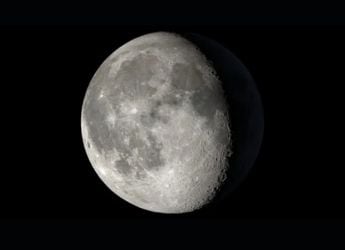- Home
- Science
- Science News
- Artemis Era Raises Safety Concerns as Lunar Orbit Nears Capacity, New Study Finds
Artemis Era Raises Safety Concerns as Lunar Orbit Nears Capacity, New Study Finds
Scientists warn that lunar orbit is becoming crowded as missions increase. With limited stable orbits, satellites may soon need frequent collision-avoidance manoeuvres.

Photo Credit: NASA
The moon has been a key target for many countries.
With the increased pace of lunar exploration, scientists caution that there is increased moon traffic. Approximately a dozen missions were attempted in 2023 and 2024, almost half of them by private ones. The space between the moon and the sun is large, but only a few stable orbits are populated by missions. Georgia Tech simulations indicate that at approximately 50 satellites orbiting the Moon, approximately four avoidance maneuvers are required annually of each satellite. As NASA Artemis missions approach, the experts are advocating improvements in the coordination and safety of future missions.
Crowded lunar orbits
According to a report by Space.com, spacecraft headed to the Moon typically pick from just a few stable orbital paths, rather than spreading out in cislunar space. Even with a few satellites active, close approaches happen: India's Chandrayaan 2 orbiter executed three collision-avoidance burns over four years, even though only six satellites shared lunar orbit during that time. With about 10–20 missions planned in the coming years, operators expect to burn fuel on many more avoidance manoeuvres to protect their spacecraft.
Tracking and coordination efforts
Agencies are developing tools to manage lunar traffic. NASA collects trajectory data from all Moon missions, using a conjunction program to flag potential collisions. The U.S. Air Force is funding new cislunar sensors: in 2025 it backed a study to build a network of tracking satellites and is building an “Oracle-Prime” satellite to launch in 2027 toward the Earth–Moon L1 point. Europe's ESA plans a Lunar Environment Monitoring Observatory (LEMO) to apply Earth-orbit monitoring methods at the Moon. International forums are involved too: the UN's COPUOS has formed a study team on lunar traffic management.
Get your daily dose of tech news, reviews, and insights, in under 80 characters on Gadgets 360 Turbo. Connect with fellow tech lovers on our Forum. Follow us on X, Facebook, WhatsApp, Threads and Google News for instant updates. Catch all the action on our YouTube channel.
Related Stories
- Samsung Galaxy Unpacked 2025
- ChatGPT
- Redmi Note 14 Pro+
- iPhone 16
- Apple Vision Pro
- Oneplus 12
- OnePlus Nord CE 3 Lite 5G
- iPhone 13
- Xiaomi 14 Pro
- Oppo Find N3
- Tecno Spark Go (2023)
- Realme V30
- Best Phones Under 25000
- Samsung Galaxy S24 Series
- Cryptocurrency
- iQoo 12
- Samsung Galaxy S24 Ultra
- Giottus
- Samsung Galaxy Z Flip 5
- Apple 'Scary Fast'
- Housefull 5
- GoPro Hero 12 Black Review
- Invincible Season 2
- JioGlass
- HD Ready TV
- Laptop Under 50000
- Smartwatch Under 10000
- Latest Mobile Phones
- Compare Phones
- OPPO Reno 15 Pro
- OPPO Reno 15
- Vivo Y500 Pro
- Realme GT 8 Pro Aston Martin F1 Limited Edition
- Huawei Mate 70 Air
- Moto G57
- Moto G57 Power
- Motorola Edge 70
- MacBook Pro 14-inch (M5, 2025)
- Asus Vivobook S16 (S3607QA)
- iQOO Pad 5e
- OPPO Pad 5
- Noise Diva 2
- Noise Halo 2
- Acerpure Nitro Z Series 100-inch QLED TV
- Samsung 43 Inch LED Ultra HD (4K) Smart TV (UA43UE81AFULXL)
- Asus ROG Ally
- Nintendo Switch Lite
- Haier 1.6 Ton 5 Star Inverter Split AC (HSU19G-MZAID5BN-INV)
- Haier 1.6 Ton 5 Star Inverter Split AC (HSU19G-MZAIM5BN-INV)
-
 Astronomers Uncover the Vast Greater Pleiades Complex with 3,000 Hidden Stars
Astronomers Uncover the Vast Greater Pleiades Complex with 3,000 Hidden Stars
-
 Astronomers Capture First-Ever Early Snapshot of Supernova Shock Wave Using ESO’s VLT
Astronomers Capture First-Ever Early Snapshot of Supernova Shock Wave Using ESO’s VLT
-
 Artemis Era Raises Safety Concerns as Lunar Orbit Nears Capacity, New Study Finds
Artemis Era Raises Safety Concerns as Lunar Orbit Nears Capacity, New Study Finds
-
 SpaceX Sends Sentinel-6B to Orbit for Precision Sea-Level Tracking
SpaceX Sends Sentinel-6B to Orbit for Precision Sea-Level Tracking












